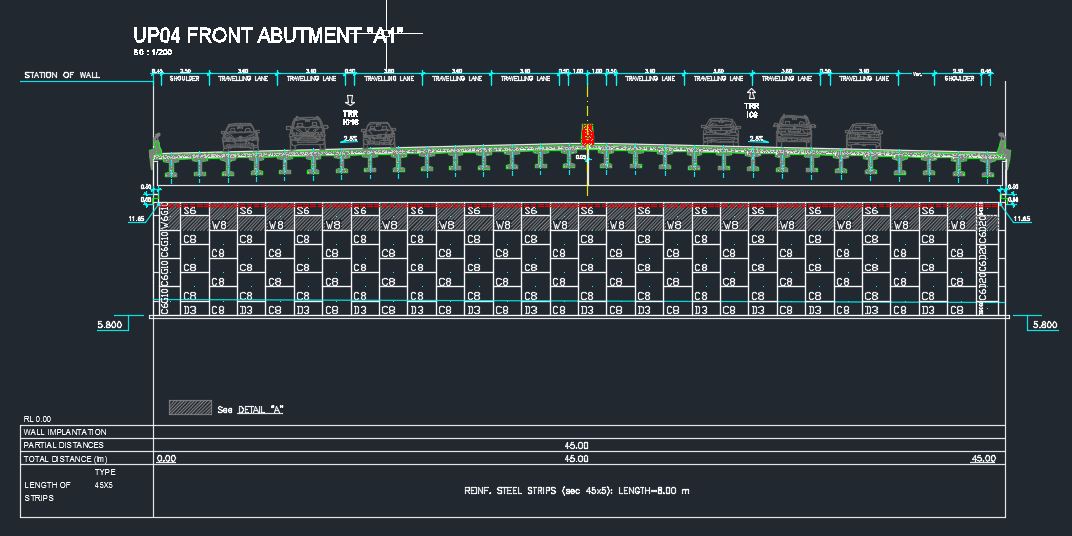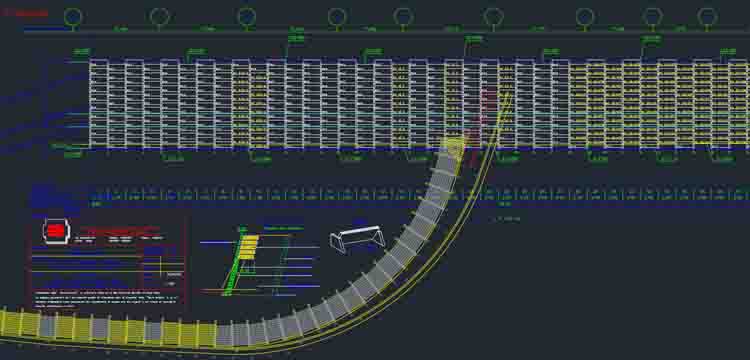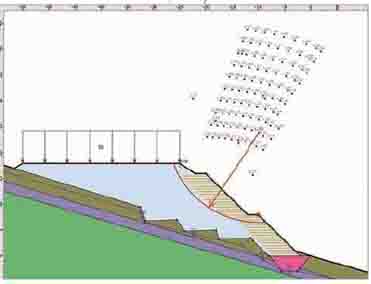
 The RECAD is a suite of programs for computer aided design of structures in Reinforced Earth, Wired Faced Green Walls (later named Terratrel) and
concrete precast Green Walls. At first conceived by Ulisse Cimolino at the French headquarters of Terre Armée assisted by Parisian designers, to whom I
joined as soon as I entered the staff of the Italian headquarters of the Terra Armata. The program was originally developed in C++ for a SCO Unix©
environment and used an Informix© database in the same operating environment.
The RECAD is a suite of programs for computer aided design of structures in Reinforced Earth, Wired Faced Green Walls (later named Terratrel) and
concrete precast Green Walls. At first conceived by Ulisse Cimolino at the French headquarters of Terre Armée assisted by Parisian designers, to whom I
joined as soon as I entered the staff of the Italian headquarters of the Terra Armata. The program was originally developed in C++ for a SCO Unix©
environment and used an Informix© database in the same operating environment.
The operation was based on the interaction of several programs managed separately by the user in the Unix and DOS environment. Through the DOS interface of
Informix we connected to the main database on the Unix server and in it were inserted the data of the project to be realized (progressive distances between the cross
sections, ground and project levels of the road or railway embankment, service life of the structure, and a whole series of parameters that defined the type of
structure to be designed). After entering the data of the project in the database, was launched the program that read data in the database and, using a series of
precompiled abacus, generated a script for AutoCAD© (from ACAD 10 to ACAD 2000).  Once the script was generated, it was executed in AutoCAD© to automatically create the design of the structure in a drawing
with a template that supported 6 different languages. The engine for these elaborations was written in C++ and compiled, first in Unix, and lately, for the Microsoft©
environment with Microsoft Quick C 5.1©.
Once the drawing was generated, the dwg file was modified through a library of functions written in AutoLISP© managed through a digitizer tablet, and when
migrated under the Windows© environment, through custom toolabrs. This library of functions allowed to modify the project by replacing or cutting the blocks
of the panels, changing the length of the reinforcement or replacing the blocks in groups. Among the others there were the functions that allowed to extract the data
in order to process them in a computation program that updated the database on the Unix server. Back in the Unix environment, using the METRE (compute) and CLASS
(elements database) applications.
Once the script was generated, it was executed in AutoCAD© to automatically create the design of the structure in a drawing
with a template that supported 6 different languages. The engine for these elaborations was written in C++ and compiled, first in Unix, and lately, for the Microsoft©
environment with Microsoft Quick C 5.1©.
Once the drawing was generated, the dwg file was modified through a library of functions written in AutoLISP© managed through a digitizer tablet, and when
migrated under the Windows© environment, through custom toolabrs. This library of functions allowed to modify the project by replacing or cutting the blocks
of the panels, changing the length of the reinforcement or replacing the blocks in groups. Among the others there were the functions that allowed to extract the data
in order to process them in a computation program that updated the database on the Unix server. Back in the Unix environment, using the METRE (compute) and CLASS
(elements database) applications.  (C++ and Informix) were extrapolated the data for the
logistics, for the prefabrication and the shipments, and for the administration for the invoicing. All this was completed by two other programs on the Unix server: AFFAIRES
(projects) and MAIL (contacts directory). For static calculations we relied on other software developed internally in DOS environment: Valdez (vertical walls
in Reinforced Earth), Thizy (walls with inclined facing in Reinforced Earth like the Terratrel and the concrete precast Green Walls), Zaraus (bridge abutments), Swansea
(floodable walls), written mostly in FORTRAN, or externally developed such as Talren by Terrasol. The standards imposed by TAI Soft then and the centralization of development
allowed in us the eighties to produce standard projects for all the European subsidiaries of the Terre Armée.
Among the applications written in AutoLISP© there were already the automated management of the layers and several options for the advanced modification of some
standard AutoCAD© entities entities such as texts and polylines, as well as the preparation of the graphic environment and plotter printouts; elements that I
would have developed more in detail with other programmers and implemented, first in the Autodesk Express Tools and lately directly for Autodesk in Autodesk in
AutoCAD©.
With the advent of Windows, the program was abandoned - integrated - converted to operate on the new platform; the digitizer has been replaced by the mouse and the development
languages replaced or integrated by other more flexible ones such as the VBA (that replaced AutoLISP) and Visual Basic to complement the C++ modules. All these new implementations were
then merged into the SITAR management software.
(C++ and Informix) were extrapolated the data for the
logistics, for the prefabrication and the shipments, and for the administration for the invoicing. All this was completed by two other programs on the Unix server: AFFAIRES
(projects) and MAIL (contacts directory). For static calculations we relied on other software developed internally in DOS environment: Valdez (vertical walls
in Reinforced Earth), Thizy (walls with inclined facing in Reinforced Earth like the Terratrel and the concrete precast Green Walls), Zaraus (bridge abutments), Swansea
(floodable walls), written mostly in FORTRAN, or externally developed such as Talren by Terrasol. The standards imposed by TAI Soft then and the centralization of development
allowed in us the eighties to produce standard projects for all the European subsidiaries of the Terre Armée.
Among the applications written in AutoLISP© there were already the automated management of the layers and several options for the advanced modification of some
standard AutoCAD© entities entities such as texts and polylines, as well as the preparation of the graphic environment and plotter printouts; elements that I
would have developed more in detail with other programmers and implemented, first in the Autodesk Express Tools and lately directly for Autodesk in Autodesk in
AutoCAD©.
With the advent of Windows, the program was abandoned - integrated - converted to operate on the new platform; the digitizer has been replaced by the mouse and the development
languages replaced or integrated by other more flexible ones such as the VBA (that replaced AutoLISP) and Visual Basic to complement the C++ modules. All these new implementations were
then merged into the SITAR management software.